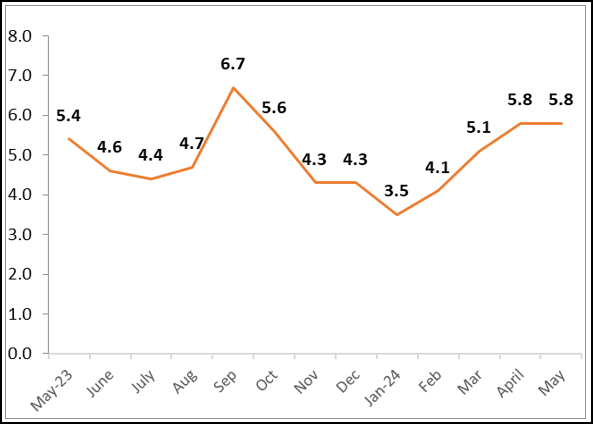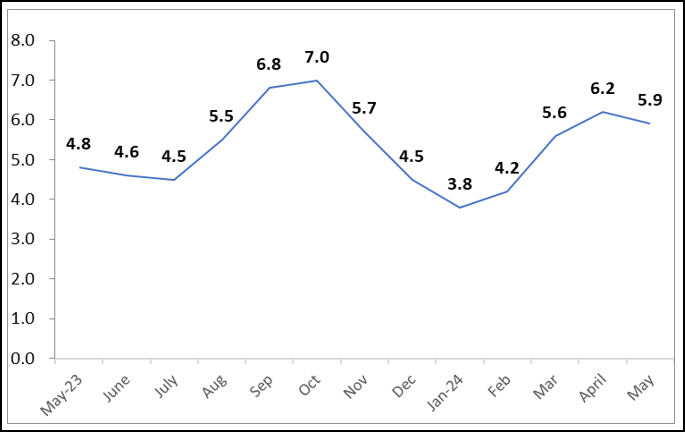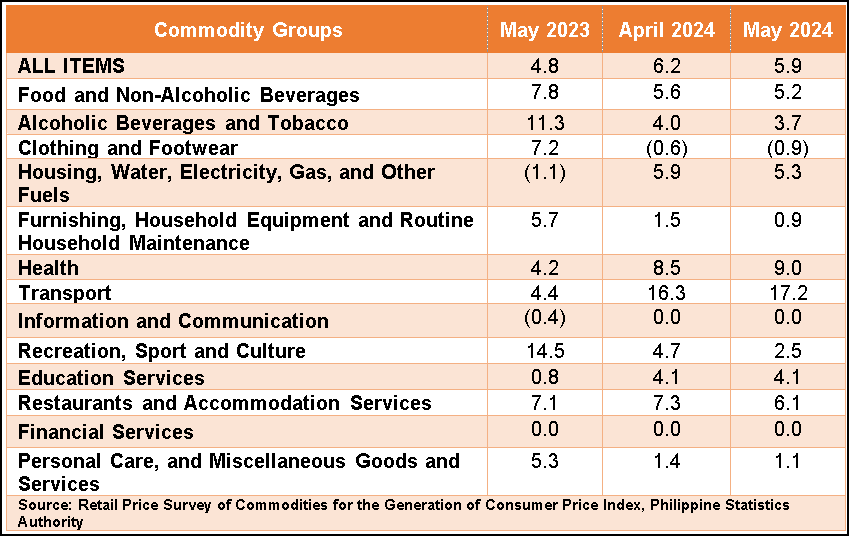Table A. Year-on-Year Inflation Rates, All Items
In percent
(2018=100)

Figure 1. Inflation Rates in CAR, All Items
(2018=100)

Source: Retail Price Survey of Commodities for the Generation of Consumer Price Index, Philippine Statistics Authority
Figure 2. Inflation Rates in Benguet, All Items
(2018=100)

Source: Retail Price Survey of Commodities for the Generation of Consumer Price Index, Philippine Statistics Authority
Table B. Year-on-Year Inflation Rates in Benguet
By Commodity Groups
In percent
(2018=100)

Benguet
Inflation in Benguet for the bottom 30% income households further decreased to 5.9 percent in May 2024, from 6.2 percent in April 2024. In May 2023, inflation was lower at 4.8 percent. (Table B and Figure 2)
The main driver in the downtrend of inflation for this group in May 2024 was food and non-alcoholic beverages at 5.2 percent, from 5.6 percent in the previous month. This was followed by housing, water, electricity, gas and other fuels at 5.3 percent from 5.9 percent, and restaurants and accommodation services at 6.1 percent, from the 7.3 percent in the previous month.
Moreover, the following also decreased during the month:
a. Alcoholic beverages and tobacco, 3.7 percent from 4.0 percent;
b. Clothing and footwear, -0.9 percent from -0.6 percent;
c. Furnishings, household equipment and routine household maintenance, 0.9 percent from 1.5 percent;
d. Health, 8.5 percent from 8.8 percent;
e. Recreation, sport and culture, 2.5 percent from 4.7 percent; and
f. Personal care, and miscellaneous goods and services, 1.1 percent from 1.4 percent.
The rest of the commodity groups retained their indices except for health and transport which increased at 9.0 and 17.2 percent, respectively.
Food Inflation
Food inflation for the bottom 30% income households at the provincial level moved at a lower pace of 5.3 percent in May 2024 from 5.7 percent in the previous month. In May 2023, its annual increase was observed at 8.0 percent.
Main Drivers to the Downward Trend of the Food Inflation
The downtrend in the food inflation was mainly due to the decrease in vegetable, tubers, plantains, cooking bananas and pulses at 4.5 percent from 8.8 percent, meat and other parts of slaughtered land animals at -2.2 percent from -1.2 percent, and fish and other seafood at 0.9 percent from 1.6 percent. Decreased were also recorded for milk, other dairy products and eggs at 2.4 percent from 3.0 percent, and sugar, confectionery and desserts at 3.6 percent from 3.4 percent.
On the contrary, increases were observed in the index of the following:
a. Oils and fats, -7.2 percent from -8.7 percent; and
b. Fruits and Nuts, 0.4 percent from -3.2 percent.
Note: CPIs and inflation rates by region, province and selected city are posted at the PSA website (https://openstat.psa.gov.ph/).
IMELDA L. BUYUCCAN (SGD)
Chief Statistical Specialist
/SMBP

